No products in the cart.
Outdoor Adventure
The Art of Swedish Trekking
At the start of the 21st century, Swedish entrepreneur and Fjällräven founder Åke Nordin had a vision for helping others explore the breathtaking landscapes of Scandinavia that he loved—like the glacier-carved fjords and valleys, sawtoothed granite peaks, and sapphire blue lakes of the Scandes Mountains. Enter the Fjällräven Classic, an organized group trek celebrating community in the outdoors along a long-distance path. It wouldn’t be a competition; in fact it would be the opposite, just a chance to walk with others and connect in the wild.
During the Classic’s inaugural year in 2005, more than 150 hikers completed more than 68 miles of the iconic Dag Hammarskjöld trail from Nikkaluokta to Abisko in Sweden. Ten years later, more than 2,100 hikers finished the same route, and it’s still the path the Classic follows today. Even as the Fjällräven Classic has grown, it remains true to the spirit Nordin established, welcoming eager trekkers of all skill levels, from first-time backpackers to seasoned outdoorists.
The emphasis on enjoying nature, not conquering it, makes for a trekking culture that’s all about slowing down, enjoying the sights and sounds, and sharing the experience with others. But that doesn’t mean you should expect a walk in the park. Nordin created Fjällräven gear to support people exploring the world’s roughest terrain and being prepared for all kinds of weather, which is exactly what you should be prepared for when heading into the wild.

“Being self-sufficient in the outdoors is not unique to the Swedish way of trekking, but I think it is a cornerstone of our events,” says Carl Hård af Segerstad, Fjällräven’s global event manager. “You carry all you need, and you are completely independent. No sherpas, no porters, and no huts or cabins like in the Alps. It’s more like an exploration expedition in that sense. But what you really explore is your own capacity and learning.”
The Classic became so popular that Fjällräven decided to spread the love. This year, the Classic is happening in five locations around the world. The original and longest trek is in Sweden, where there’s the potential to see reindeer in the wild. The trek in Denmark passes through charming villages and farmlands. Germany’s hike drops participants into the Allgäu Alps, and Korea’s route enters Mt. Hallasan National Park. And lastly, the Classic in the United States travels deep into the Colorado backcountry. Each location offers unique scenery, experiences, and challenges. Trekkers carry all their gear on their backs and Fjällräven takes care of the rest, from transport to route planning, plus the company provides a few surprises and delights along the way.

To help minimize the impact of the Classic, Fjällräven teams up with partners like Leave No Trace in the U.S. and Patron Plasticfree Peaks in Germany. The goal everywhere is to educate and inspire participants to tread gently and carefully on the trail.
“Thanks to public land being open and accessible to everyone, it is everyone’s right to make use of it and share the responsibility,” says Hård af Segerstad. “But it is also our responsibility to make it open and accessible to all people.”
You don’t need a ticket to spend time in nature or along the same routes. You can explore the routes through the Fjällräven Classic website—and mark your calendar for the 2024 season.
“Time in nature is always special,” says Hård af Segerstad. He calls out benefits like reduced stress levels, improved attention and concentration, greater strength and balance, and increased hopes for the future and belief in one’s own capabilities.
“I have seen these positive effects happen over and over again with different people participating at the Fjällräven Classic and that is truly special.”

In 1960, Åke Nordin founded Fjällräven in his basement in the Swedish town of Örnsköldsvik. Since then the brand has stayed true to its mission of developing timeless, functional, and durable outdoor equipment, acting responsibly toward people, animals, and the environment, and inspiring more people to discover outdoor life.
Source link

